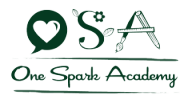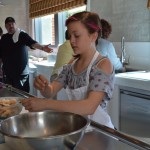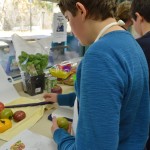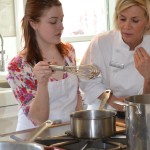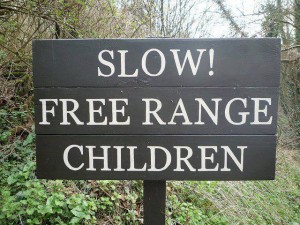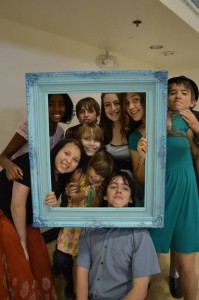In July, 2011, my husband Todd and I founded One Spark Academy. Within a week or so after choosing its name, we had a business license, website, teachers, a location, and seven students. Compared to other educational endeavors of which I’d been part, the founding of One Spark Academy was a cakewalk. Thankfully, that was the plan: to create a place where creative ideas could be nurtured without “red tape” getting in the way, and where learning would happen in a positive, calm environment, absent the burdens of regulatory restraints, standardization, or a “check off the box” approach to work production.
But, One Spark Academy didn’t just fall out of the sky. In fact, it had been evolving long before we gave it a name.
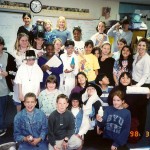 The foundation of One Spark Academy actually began in 1994, as a percolating series of ideas and observations about education. I had just completed my teacher training at Blanche Reynolds Open Classroom in Ventura, which later branched off to create Ventura Charter School. What I saw there changed me, and would lay the foundation for my vision of how learning should be. The next year, I started my career as an educator in the Conejo Valley Unified School District’s Open Classroom. CVUSD’s Open Classroom was a special pilot program at that time, with three classrooms in grades K-4, and its founding philosophy rooted in whole-child education. Within just a few years, the program grew to six classrooms and extended through 6th grade.
The foundation of One Spark Academy actually began in 1994, as a percolating series of ideas and observations about education. I had just completed my teacher training at Blanche Reynolds Open Classroom in Ventura, which later branched off to create Ventura Charter School. What I saw there changed me, and would lay the foundation for my vision of how learning should be. The next year, I started my career as an educator in the Conejo Valley Unified School District’s Open Classroom. CVUSD’s Open Classroom was a special pilot program at that time, with three classrooms in grades K-4, and its founding philosophy rooted in whole-child education. Within just a few years, the program grew to six classrooms and extended through 6th grade.
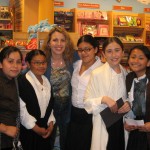
During those early years, creativity flourished! I had time to put together cross-age lessons that were student-driven. As the program’s team leader for most of my 15-year tenure, I sat on numerous committees and helped drive much of the program’s philosophy and development with a core group of outstanding educators. Over the years, I helped create and/or lead festivals, events, traditions, plays… as well as events for Conejo Elementary (the main campus where our program resided), like spelling bees, the Geography Bee, Student Council, DARE graduations, Women in History, Honor Roll, you name it. If it motivated kids, I was game.
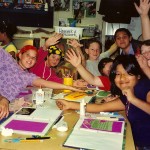 By 2003, I had found time to pursue my Master’s Degree in Education and my Preliminary Administrative Services Credential. I also enjoyed traveling during summers and breaks. But with each passing year, I noticed it was getting harder to creatively meet the needs of my learners, and connect with them and their families, while enriching my own learning. More of my personal time was encroached upon by the rising demand and stress of new regulations, new administrators, teacher training, curriculum development, tests, and meetings. Most of my weekends and evenings were swallowed up in work: futile attempts to catch up, clean up my classroom and finish grading papers. Sometimes, I would dread the start of the week, especially if I had run out of time to plan the lessons that I knew motivated kids. I started waking up at 4:30 AM so I could have more hours to work before school.
By 2003, I had found time to pursue my Master’s Degree in Education and my Preliminary Administrative Services Credential. I also enjoyed traveling during summers and breaks. But with each passing year, I noticed it was getting harder to creatively meet the needs of my learners, and connect with them and their families, while enriching my own learning. More of my personal time was encroached upon by the rising demand and stress of new regulations, new administrators, teacher training, curriculum development, tests, and meetings. Most of my weekends and evenings were swallowed up in work: futile attempts to catch up, clean up my classroom and finish grading papers. Sometimes, I would dread the start of the week, especially if I had run out of time to plan the lessons that I knew motivated kids. I started waking up at 4:30 AM so I could have more hours to work before school.
Numerous trainings and summer workshops for exciting thematic units fell by the wayside; there was little room for subjects that wouldn’t be tested. No Child Left Behind drove a push to standardize curriculum and forced education teams to focus their planning on analyzing data, diagnosing kids, and prepping for state tests, rather than highlighting student strengths or figuring out ways to meet unique learning styles. And I wasn’t alone in my observations. Discussions about homework, testing, and the need for more progressive education became part of a national conversation, combined with movies such as Race to Nowhere and Waiting for Superman. The debates prompted many calls to action but, in such a climate, good ideas seemed too difficult or costly for entire districts to implement. More and more teachers I knew were increasingly frustrated by their inability to do what they felt was right for their students. It became tougher to be an administrator too. In 15 years at CVUSD, I worked under eight different administrators, each one bringing his or her own vision, challenging the staff’s desire for continuity.
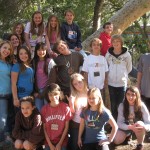
Additionally, some of my 6th graders went off to middle school only to find their passion for learning wane. They’d come back to tell me they missed the connection, writing, projects, speeches, creative time, Circle, mentoring, and their little buddies, all of which they experienced in Open Classroom. It wasn’t surprising when they shared what they didn’t like about middle school: bullies, peer pressure, drugs, distractions, and too much homework. Some encountered serious emotional stress, and/or left to homeschool. Parents of these students often felt stuck. Some families became ravaged by the pressures, concerns, and the stress-related illnesses their kids were facing.
I had pursued my administrative credential in case I was offered the opportunity to be the program’s administrator, expand it (maybe to middle school?) and help secure its “whole child” principles of creativity, projects, healthy habits, environmental education, and so forth, since these tenets were being challenged by the focus on standardization and benchmarks. I wanted to see more kids benefit from what I saw was possible in education– education from the inside out.
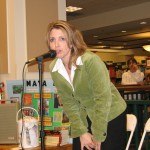 But, being in a classroom was my life, and I saw myself every bit the learner as I was a teacher. I loved planning events such as Women in History each year, taking kids on field trips, seeing students’ talents and confidence ignite when they did a speech, leading literature groups, and helping kids work through math problems. I also loved the Open Classroom with a passion. I was an advocate for kids and families and loved speaking out about my convictions and the program’s mission.
But, being in a classroom was my life, and I saw myself every bit the learner as I was a teacher. I loved planning events such as Women in History each year, taking kids on field trips, seeing students’ talents and confidence ignite when they did a speech, leading literature groups, and helping kids work through math problems. I also loved the Open Classroom with a passion. I was an advocate for kids and families and loved speaking out about my convictions and the program’s mission.
Sadly, when budget cuts hit the state, solid teaching teams everywhere were hit hard. Fresh, new, energetic teachers with up to five years of experience began getting laid off (or “pink slipped”) in droves, bringing more upheaval. We were not immune. In 2009, the Open Classroom lost four members of its team, out of six. Enough was enough. So, prompted by the requests and frustrations of many parents and kids, I decided to write the framework for a K-8 charter school. It wasn’t an easy decision; I knew that following my heart would be hard on many people I cared about, including my closest colleagues. I considered leaving education entirely, but too many families were counting on me to press on.
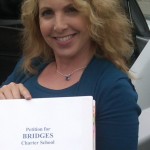 Over that next summer, I wrote the charter and became a lead petitioner (along with Laura Erlig and Jon Baker) of a founding group that worked tirelessly to get the school off the ground. Laura and educator Liza Scheer also served with me on a program development team to map out how the vision would be implemented in the classrooms of our future school. During the subsequent school year, Laura and I continued to work at Open Classroom as team partners. It wasn’t easy. Some people in the school and the district stopped speaking to us. I was kicked off of committees, and our efforts were dragged through the press. But, we showed up to work every day, staying strong for our students. After the district expectedly declined our petition, the charter school was approved by the Ventura County Office of Education in February 2010. With heavy hearts about leaving a program we loved, Laura and I resigned in June 2010 from our CVUSD positions, relinquished our tenure, and readied ourselves for the next chapter of our lives.
Over that next summer, I wrote the charter and became a lead petitioner (along with Laura Erlig and Jon Baker) of a founding group that worked tirelessly to get the school off the ground. Laura and educator Liza Scheer also served with me on a program development team to map out how the vision would be implemented in the classrooms of our future school. During the subsequent school year, Laura and I continued to work at Open Classroom as team partners. It wasn’t easy. Some people in the school and the district stopped speaking to us. I was kicked off of committees, and our efforts were dragged through the press. But, we showed up to work every day, staying strong for our students. After the district expectedly declined our petition, the charter school was approved by the Ventura County Office of Education in February 2010. With heavy hearts about leaving a program we loved, Laura and I resigned in June 2010 from our CVUSD positions, relinquished our tenure, and readied ourselves for the next chapter of our lives.
Unfortunately, soon after embarking on our first year in the new school, we came to find that a new level of politics and bureaucracy continued on with the public charter school. My vision, as set forth in the Charter, was a challenge to implement and my voice was fiercely overruled by members of the school’s new administration. I became convinced that I didn’t have the support to build the school (and middle school program) that I envisioned and promised the community. So, I decided to resign my position as Education Team Leader on June 12, 2011. Walking away from a good salary and health benefits was of little importance to me. At that moment, after so many years of trying to move education in a new direction, I would have rather volunteered my time to pursue what I believed than to work in a way that felt contrary to my convictions. (Little did I know that I would be volunteering my time a lot longer than expected!). Although the months leading up to my resignation were the hardest of my life, I knew that I would be guided by a vision, one that had been my compass for more than 16 years, and the support of many who knew my heart and intentions.
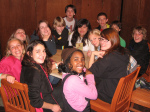 Miraculously, it would be the students who ignited the next flame. In July 2011, I was contacted by several families who wanted to help me. Parents were prepared to homeschool their kids if it meant their children could learn in the way we had envisioned. A few brainstorming meetings with supporters ensued, and the clouds lifted. The positivity we started to feel again was incredible! The Teen Center leaders believed in us too and agreed to rent us space for our classes. The name, One Spark Academy, was perfect for how this new “out of the box” learning center would proceed.
Miraculously, it would be the students who ignited the next flame. In July 2011, I was contacted by several families who wanted to help me. Parents were prepared to homeschool their kids if it meant their children could learn in the way we had envisioned. A few brainstorming meetings with supporters ensued, and the clouds lifted. The positivity we started to feel again was incredible! The Teen Center leaders believed in us too and agreed to rent us space for our classes. The name, One Spark Academy, was perfect for how this new “out of the box” learning center would proceed.
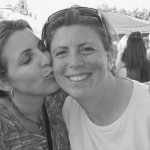 Thankfully, Laura and Liza were on board. We all agreed that this next chapter in our careers would be aligned under a single vision, and our commitment would be to create an environment where we could teach in the way we believed, without red tape, restrictions, or “feel-bad” management that too often makes teaching and learning a stressful experience. Compared to the charter school, which had taken an emotional and physical toll on us after two years of mostly 16 hour days, 7 days a week, One Spark Academy was up and running in just a few days from its conception. Our creative spirits opened up and we enthusiastically developed new classes (such as Food Fascination, Math at Your Level, Ancient Journeys…) with our small group of students in mind. We had time to problem solve, space to breathe, good energy, compassion, and love. During this process, our hearts healed and our passion for teaching came alive again. Numerous families told us they had sought refuge inside our doors, and stayed because we offered such an incredible, flexible, and positive learning opportunity.
Thankfully, Laura and Liza were on board. We all agreed that this next chapter in our careers would be aligned under a single vision, and our commitment would be to create an environment where we could teach in the way we believed, without red tape, restrictions, or “feel-bad” management that too often makes teaching and learning a stressful experience. Compared to the charter school, which had taken an emotional and physical toll on us after two years of mostly 16 hour days, 7 days a week, One Spark Academy was up and running in just a few days from its conception. Our creative spirits opened up and we enthusiastically developed new classes (such as Food Fascination, Math at Your Level, Ancient Journeys…) with our small group of students in mind. We had time to problem solve, space to breathe, good energy, compassion, and love. During this process, our hearts healed and our passion for teaching came alive again. Numerous families told us they had sought refuge inside our doors, and stayed because we offered such an incredible, flexible, and positive learning opportunity.
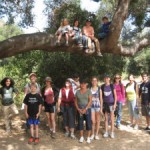 In August 2011, One Spark Academy started its first session with seven kids and four teachers. By October 2015, more than 120 students have benefitted from our classes, and our staff has grown to 11 full and part-time educators and support personnel. In our first year alone, we were recognized in the news for our healthy cooking and our Women in History event. We’ve taken kids and parent chaperones to Yosemite, Washington’s Olympic Peninsula, Santa Cruz Island, and the Santa Monica Mountains for incredible adventures. We’ve held cooking labs at the California Health and Longevity Institute in the Four Seasons, Westlake. We’ve created two cookbooks, launched a new website, and became a non-profit corporation. We’ve documented our progress and passions in numerous videos. We’ve built a stellar reputation for “walking the walk”, even if many still don’t quite know how to define us. We’re not perfect, and we’re certainly still figuring it out, but we’ve shown that when good ideas percolate amongst a group of talented, motivated and committed individuals, great things happen, and they can happen fast! At One Spark Academy, we allow those sparks to ignite. And, isn’t that the purpose of education? To unwrap potential, rather than stifle it? We think so.
In August 2011, One Spark Academy started its first session with seven kids and four teachers. By October 2015, more than 120 students have benefitted from our classes, and our staff has grown to 11 full and part-time educators and support personnel. In our first year alone, we were recognized in the news for our healthy cooking and our Women in History event. We’ve taken kids and parent chaperones to Yosemite, Washington’s Olympic Peninsula, Santa Cruz Island, and the Santa Monica Mountains for incredible adventures. We’ve held cooking labs at the California Health and Longevity Institute in the Four Seasons, Westlake. We’ve created two cookbooks, launched a new website, and became a non-profit corporation. We’ve documented our progress and passions in numerous videos. We’ve built a stellar reputation for “walking the walk”, even if many still don’t quite know how to define us. We’re not perfect, and we’re certainly still figuring it out, but we’ve shown that when good ideas percolate amongst a group of talented, motivated and committed individuals, great things happen, and they can happen fast! At One Spark Academy, we allow those sparks to ignite. And, isn’t that the purpose of education? To unwrap potential, rather than stifle it? We think so.
~Lori Peters
If you want to help support our mission, please consider making a donation. Thank you!
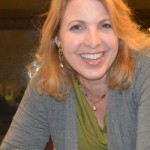 About the author: Lori Peters is the Founder, Executive Director, and an Educator at One Spark Academy. While she admits to loving homemade dessert and ice cream as much as she loves salads, sushi, and vegetables, she believes schools have a moral imperative to teach and model healthy habits. Lori is most in her element when working with creative kids who love to learn and passionate teachers who love to teach.
About the author: Lori Peters is the Founder, Executive Director, and an Educator at One Spark Academy. While she admits to loving homemade dessert and ice cream as much as she loves salads, sushi, and vegetables, she believes schools have a moral imperative to teach and model healthy habits. Lori is most in her element when working with creative kids who love to learn and passionate teachers who love to teach.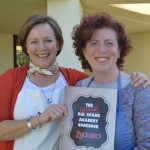 Jerri Baker (L) and Laura Holt-Erlig (R) with our 2012-2013 One Spark Academy Cookbook.
Jerri Baker (L) and Laura Holt-Erlig (R) with our 2012-2013 One Spark Academy Cookbook.